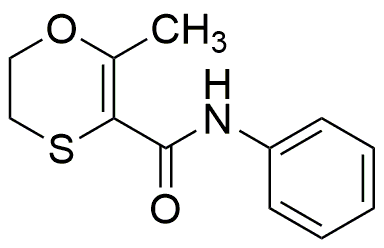Carboxin is widely utilized in research focused on:
- Agricultural Fungicide: It is primarily used as a seed treatment to protect crops from fungal diseases, enhancing seed germination and plant health.
- Plant Protection: Carboxin helps in controlling soil-borne pathogens, making it invaluable in the cultivation of crops like wheat and barley, thereby increasing yield and quality.
- Research in Plant Pathology: Researchers use it to study the effects of fungal infections on plants, providing insights into disease resistance and management strategies.
- Development of New Formulations: The compound is used in the development of advanced fungicide formulations, improving efficacy and reducing environmental impact compared to older chemicals.
- Integrated Pest Management (IPM): Carboxin plays a role in IPM strategies, allowing farmers to combine chemical and biological controls for sustainable agriculture.
General Information
Properties
Safety and Regulations
Applications
Carboxin is widely utilized in research focused on:
- Agricultural Fungicide: It is primarily used as a seed treatment to protect crops from fungal diseases, enhancing seed germination and plant health.
- Plant Protection: Carboxin helps in controlling soil-borne pathogens, making it invaluable in the cultivation of crops like wheat and barley, thereby increasing yield and quality.
- Research in Plant Pathology: Researchers use it to study the effects of fungal infections on plants, providing insights into disease resistance and management strategies.
- Development of New Formulations: The compound is used in the development of advanced fungicide formulations, improving efficacy and reducing environmental impact compared to older chemicals.
- Integrated Pest Management (IPM): Carboxin plays a role in IPM strategies, allowing farmers to combine chemical and biological controls for sustainable agriculture.
Documents
Safety Data Sheets (SDS)
The SDS provides comprehensive safety information on handling, storage, and disposal of the product.
Product Specification (PS)
The PS provides a comprehensive breakdown of the product’s properties, including chemical composition, physical state, purity, and storage requirements. It also details acceptable quality ranges and the product's intended applications.
Certificates of Analysis (COA)
Search for Certificates of Analysis (COA) by entering the products Lot Number. Lot and Batch Numbers can be found on a product’s label following the words ‘Lot’ or ‘Batch’.
*Catalog Number
*Lot Number
Certificates Of Origin (COO)
This COO confirms the country where the product was manufactured, and also details the materials and components used in it and whether it is derived from natural, synthetic, or other specific sources. This certificate may be required for customs, trade, and regulatory compliance.
*Catalog Number
*Lot Number
Safety Data Sheets (SDS)
The SDS provides comprehensive safety information on handling, storage, and disposal of the product.
DownloadProduct Specification (PS)
The PS provides a comprehensive breakdown of the product’s properties, including chemical composition, physical state, purity, and storage requirements. It also details acceptable quality ranges and the product's intended applications.
DownloadCertificates of Analysis (COA)
Search for Certificates of Analysis (COA) by entering the products Lot Number. Lot and Batch Numbers can be found on a product’s label following the words ‘Lot’ or ‘Batch’.
*Catalog Number
*Lot Number
Certificates Of Origin (COO)
This COO confirms the country where the product was manufactured, and also details the materials and components used in it and whether it is derived from natural, synthetic, or other specific sources. This certificate may be required for customs, trade, and regulatory compliance.


